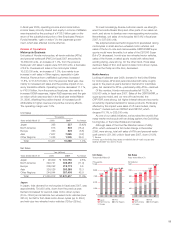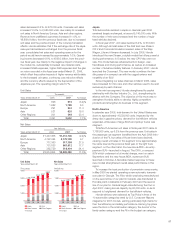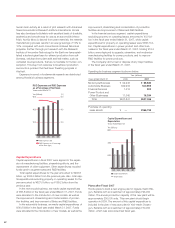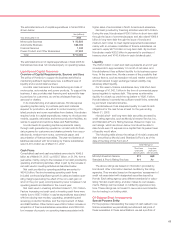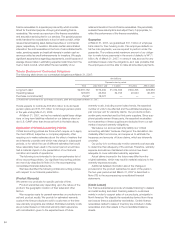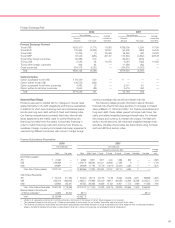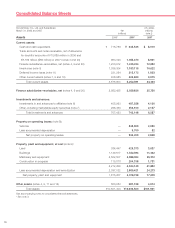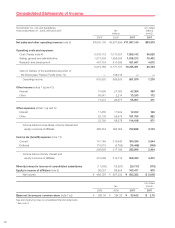Honda 2007 Annual Report Download - page 66
Download and view the complete annual report
Please find page 66 of the 2007 Honda annual report below. You can navigate through the pages in the report by either clicking on the pages listed below, or by using the keyword search tool below to find specific information within the annual report.
64
Tabular Disclosure of Contractual Obligations
The following table shows our contractual obligations at March 31, 2007:
Yen (millions)
Payments due by period
Total Less than 1 year 1-3 years 3-5 years After 5 years
Long-term debt ¥2,681,152 ¥775,409 ¥1,374,355 ¥504,705 ¥26,683
Operating leases 128,978 25,354 34,703 23,543 45,378
Purchase commitments(*) 78,027 78,027 — — —
(*) Honda had commitments for purchases of property, plant and equipment at March 31, 2007.
Honda expects to contribute ¥33,953 million to its domestic
pension plans and ¥37,187 million to its foreign pension plans
in the year ending March 31, 2008.
At March 31, 2007, we had no material capital lease obliga-
tions or long-term liabilities reflected on our balance sheet un-
der U.S. GAAP other than those set forth in the table above.
Application of Critical Accounting Policies
Critical accounting policies are those which require us to apply
the most difficult, subjective or complex judgments, often
requiring us to make estimates about the effect of matters that
are inherently uncertain and which may change in subsequent
periods, or for which the use of different estimates that could
have reasonably been used in the current period would have
had a material impact on the presentation of our financial
condition and results of operations.
The following is not intended to be a comprehensive list of
all our accounting policies. Our significant accounting policies
are more fully described in Note (1) to the accompanying
consolidated financial statements.
We have identified the following critical accounting policies
with respect to our financial presentation.
(Product Warranty)
We warrant our products for specific periods of time.
Product warranties vary depending upon the nature of the
product, the geographic location of their sales and other
factors.
We recognize costs for general warranties on products we
sell and product recalls. We provide for estimated warranty
costs at the time products are sold to customers or the time
new warranty programs are initiated. Estimated warranty costs
are provided based on historical warranty claim experience
with consideration given to the expected level of future
warranty costs, including current sales trends, the expected
number of units to be affected and the estimated average re-
pair cost per unit for warranty claims. Our products contain
certain parts manufactured by third party suppliers. Since sup-
pliers typically warrant these parts, the expected receivables
from warranties of these suppliers are deducted from our esti-
mates of accrued warranty obligations.
We believe our accrued warranty liability is a “critical
accounting estimate” because changes in the calculation can
materially affect net income, and require us to estimate the
frequency and amounts of future claims, which are inherently
uncertain.
Our policy is to continuously monitor warranty cost accruals
to determine their adequacy of the accrual. Therefore, warranty
expense accruals are maintained at an amount we deem
adequate to cover estimated warranty expenses.
Actual claims incurred in the future may differ from the
original estimates, which may result in material revisions to the
warranty expense accruals.
Additional detailed information about the changes in
provisions for the product warranties for each of the years in
the two-year period ended March 31, 2007 is described in
Note (18) to the accompanying consolidated financial
statements.
(Credit Losses)
Our finance subsidiaries provide wholesale financing to dealers
and retail lending and direct financing leases to customers
mainly in order to support sales of our products, principally in
North America. We classify the receivables derived from those
services as finance subsidiaries-receivables. Certain finance
receivables related to sales of inventory are included in trade
receivables and other assets in the consolidated balance
sheets.
finance receivables to a special purpose entity, which is estab-
lished for the limited purpose of buying and reselling finance
receivables. We remain as a servicer of the finance receivables
and are paid a servicing fee for our services. The special purpose
entity transfers the receivables to a trust or bank conduit, which
issues interest-bearing asset-backed securities or commercial
paper, respectively, to investors. We retain certain subordinated
interests in the sold receivables in the form of subordinated certifi-
cates, servicing assets and residual interests in certain cash re-
serves provided as credit enhancements for investors. We apply
significant assumptions regarding prepayments, credit losses and
average interest rates in estimating expected cash flows from the
trust or bank conduit, which affect the recoverability of our
retained interests in the sold finance receivables. We periodically
evaluate these assumptions and adjust them, if appropriate, to
reflect the performance of the finance receivables.
Guarantee
At March 31, 2007, we guaranteed ¥41.1 billion of employee
bank loans for their housing costs. If an employee defaults on
his/her loan payments, we are required to perform under the
guarantee. The undiscounted maximum amount of our obliga-
tion to make future payments in the event of defaults is ¥41.1
billion. As of March 31, 2007, no amount was accrued for any
estimated losses under the obligations, as it was probable that
the employees would be able to make all scheduled payments.



